2016 NISSAN 370Z ROADSTER warning
[x] Cancel search: warningPage 16 of 27
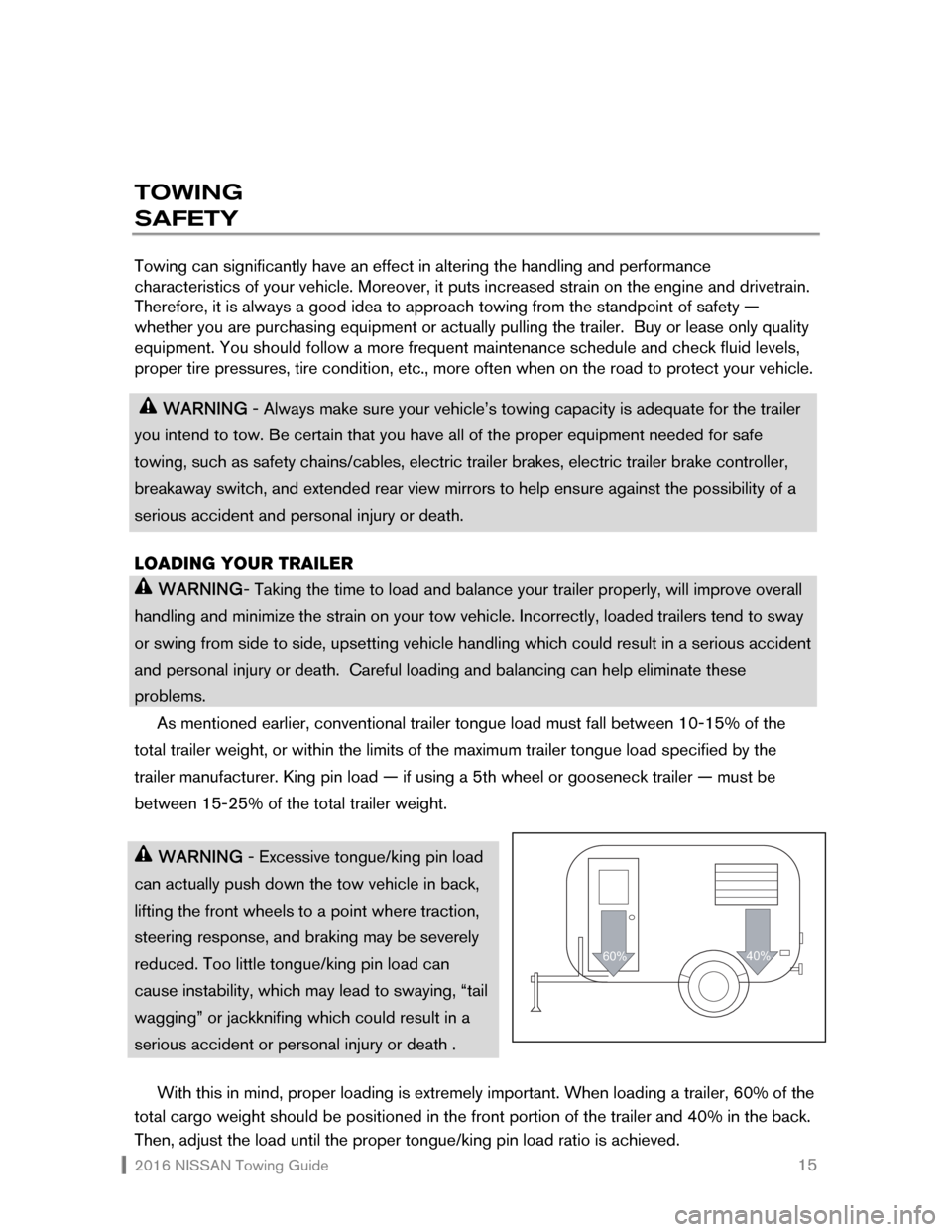
2016 NISSAN Towing Guide 15
TOWING
SAFETY
Towing can significantly have an effect in altering the handling and performance
characteristics of your vehicle. Moreover, it puts increased strain on the engine and drivetrain.
Therefore, it is always a good idea to approach towing from the standpoint of safety —
whether you are purchasing equipment or actually pulling the trailer. Buy or lease only quality
equipment. You should follow a more frequent maintenance schedule and check fluid levels,
proper tire pressures, tire condition, etc., more often when on the road to protect your vehicle.
WARNING - Always make sure your vehicle’s towing capacity is adequate for the trailer
you intend to tow. Be certain that you have all of the proper equipment needed for safe
towing, such as safety chains/cables, electric trailer brakes, electric trailer brake controller,
breakaway switch, and extended rear view mirrors to help ensure against the possibility of a
serious accident and personal injury or death.
LOADING YOUR TRAILER
WARNING- Taking the time to load and balance your trailer properly, will improve overall
handling and minimize the strain on your tow vehicle. Incorrectly, loaded trailers tend to sway
or swing from side to side, upsetting vehicle handling which could result in a serious accident
and personal injury or death. Careful loading and balancing can help eliminate these
problems.
As mentioned earlier, conventional trailer tongue load must fall between 10-15% of the
total trailer weight, or within the limits of the maximum trailer tongue load specified by the
trailer manufacturer. King pin load — if using a 5th wheel or gooseneck trailer — must be
between 15-25% of the total trailer weight.
WARNING - Excessive tongue/king pin load
can actually push down the tow vehicle in back,
lifting the front wheels to a point where traction,
steering response, and braking may be severely
reduced. Too little tongue/king pin load can
cause instability, which may lead to swaying, “tail
wagging” or jackknifing which could result in a
serious accident or personal injury or death .
With this in mind, proper loading is extremely important. When loading a trailer, 60% of the
total cargo weight should be positioned in the front portion of the trailer and 40% in the back.
Then, adjust the load until the proper tongue/king pin load ratio is achieved.
60%40%
Page 17 of 27
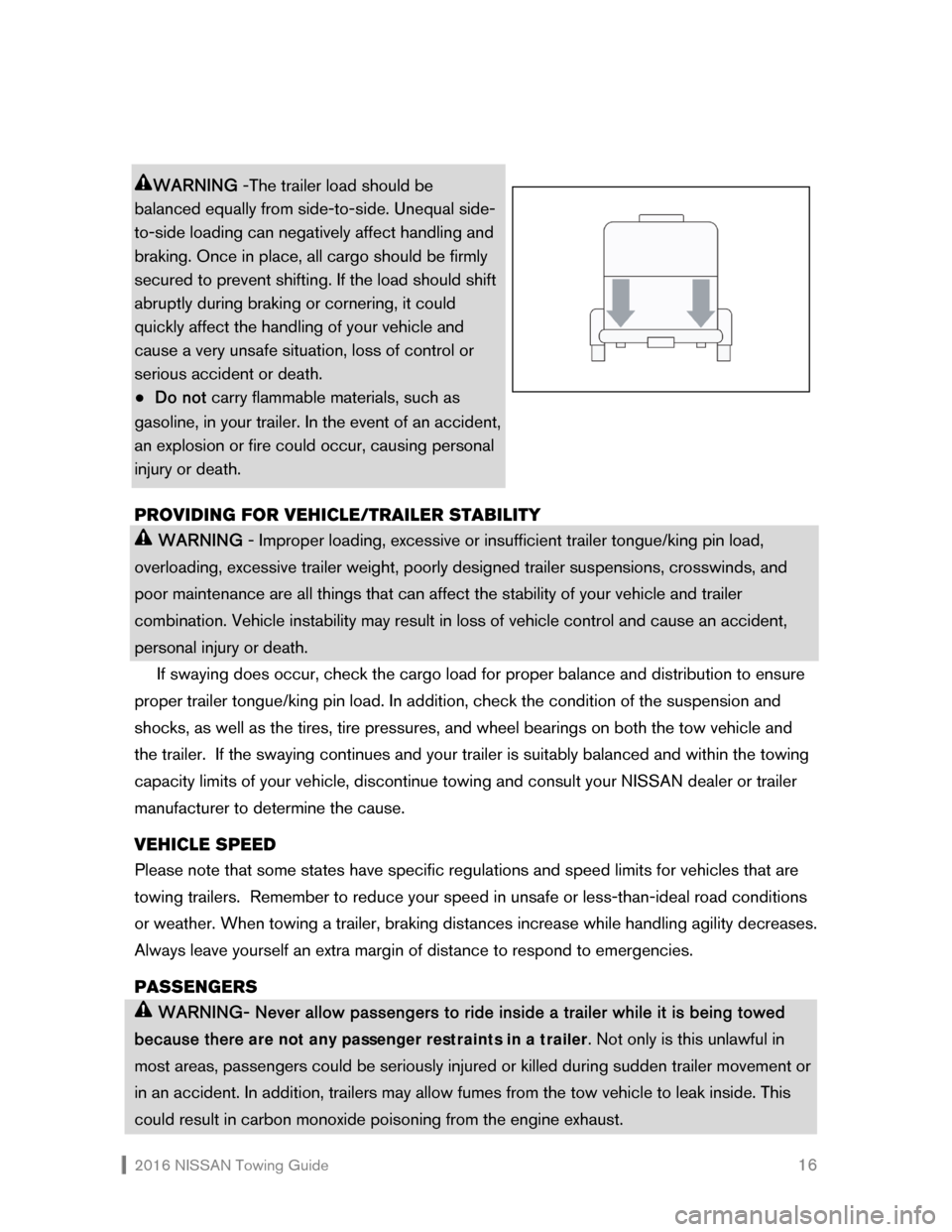
2016 NISSAN Towing Guide 16
WARNING -The trailer load should be
balanced equally from side-to-side. Unequal side-
to-side loading can negatively affect handling and
braking. Once in place, all cargo should be firmly
secured to prevent shifting. If the load should shift
abruptly during braking or cornering, it could
quickly affect the handling of your vehicle and
cause a very unsafe situation, loss of control or
serious accident or death.
● Do not carry flammable materials, such as
gasoline, in your trailer. In the event of an accident,
an explosion or fire could occur, causing personal
injury or death.
PROVIDING FOR VEHICLE/TRAILER STABILITY
WARNING - Improper loading, excessive or insufficient trailer tongue/king pin load,
overloading, excessive trailer weight, poorly designed trailer suspensions, crosswinds, and
poor maintenance are all things that can affect the stability of your vehicle and trailer
combination. Vehicle instability may result in loss of vehicle control and cause an accident,
personal injury or death.
If swaying does occur, check the cargo load for proper balance and distribution to ensure
proper trailer tongue/king pin load. In addition, check the condition of the suspension and
shocks, as well as the tires, tire pressures, and wheel bearings on both the tow vehicle and
the trailer. If the swaying continues and your trailer is suitably balanced and within the towing
capacity limits of your vehicle, discontinue towing and consult your NISSAN dealer or trailer
manufacturer to determine the cause.
VEHICLE SPEED
Please note that some states have specific regulations and speed limits for vehicles that are
towing trailers. Remember to reduce your speed in unsafe or less-than-ideal road conditions
or weather. When towing a trailer, braking distances increase while handling agility decreases.
Always leave yourself an extra margin of distance to respond to emergencies.
PASSENGERS
WARNING- Never allow passengers to ride inside a trailer while it is being towed
because there
are not any passenger restraints in a trailer. Not only is this unlawful in
most areas, passengers could be seriously injured or killed during sudden trailer movement or
in an accident. In addition, trailers may allow fumes from the tow vehicle to leak inside. This
could result in carbon monoxide poisoning from the engine exhaust.
Page 18 of 27
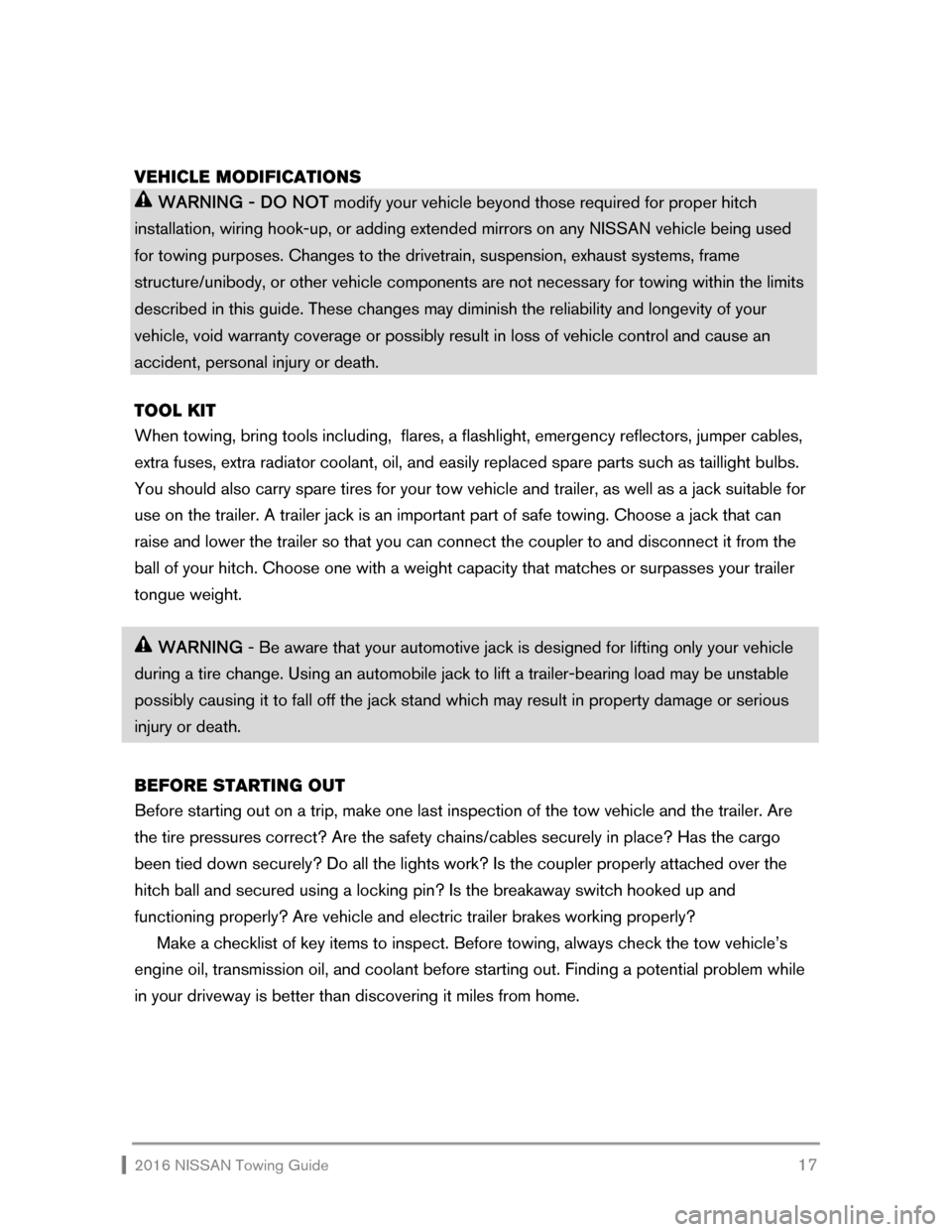
2016 NISSAN Towing Guide 17
VEHICLE MODIFICATIONS
WARNING - DO NOT modify your vehicle beyond those required for proper hitch
installation, wiring hook-up, or adding extended mirrors on any NISSAN vehicle being used
for towing purposes. Changes to the drivetrain, suspension, exhaust systems, frame
structure/unibody, or other vehicle components are not necessary for towing within the limits
described in this guide. These changes may diminish the reliability and longevity of your
vehicle, void warranty coverage or possibly result in loss of vehicle control and cause an
accident, personal injury or death.
TOOL KIT
When towing, bring tools including, flares, a flashlight, emergency reflectors, jumper cables,
extra fuses, extra radiator coolant, oil, and easily replaced spare parts such as taillight bulbs.
You should also carry spare tires for your tow vehicle and trailer, as well as a jack suitable for
use on the trailer. A trailer jack is an important part of safe towing. Choose a jack that can
raise and lower the trailer so that you can connect the coupler to and disconnect it from the
ball of your hitch. Choose one with a weight capacity that matches or surpasses your trailer
tongue weight.
WARNING - Be aware that your automotive jack is designed for lifting only your vehicle
during a tire change. Using an automobile jack to lift a trailer-bearing load may be unstable
possibly causing it to fall off the jack stand which may result in property damage or serious
injury or death.
BEFORE STARTING OUT
Before starting out on a trip, make one last inspection of the tow vehicle and the trailer. Are
the tire pressures correct? Are the safety chains/cables securely in place? Has the cargo
been tied down securely? Do all the lights work? Is the coupler properly attached over the
hitch ball and secured using a locking pin? Is the breakaway switch hooked up and
functioning properly? Are vehicle and electric trailer brakes working properly?
Make a checklist of key items to inspect. Before towing, always check the tow vehicle’s
engine oil, transmission oil, and coolant before starting out. Finding a potential problem while
in your driveway is better than discovering it miles from home.
Page 19 of 27
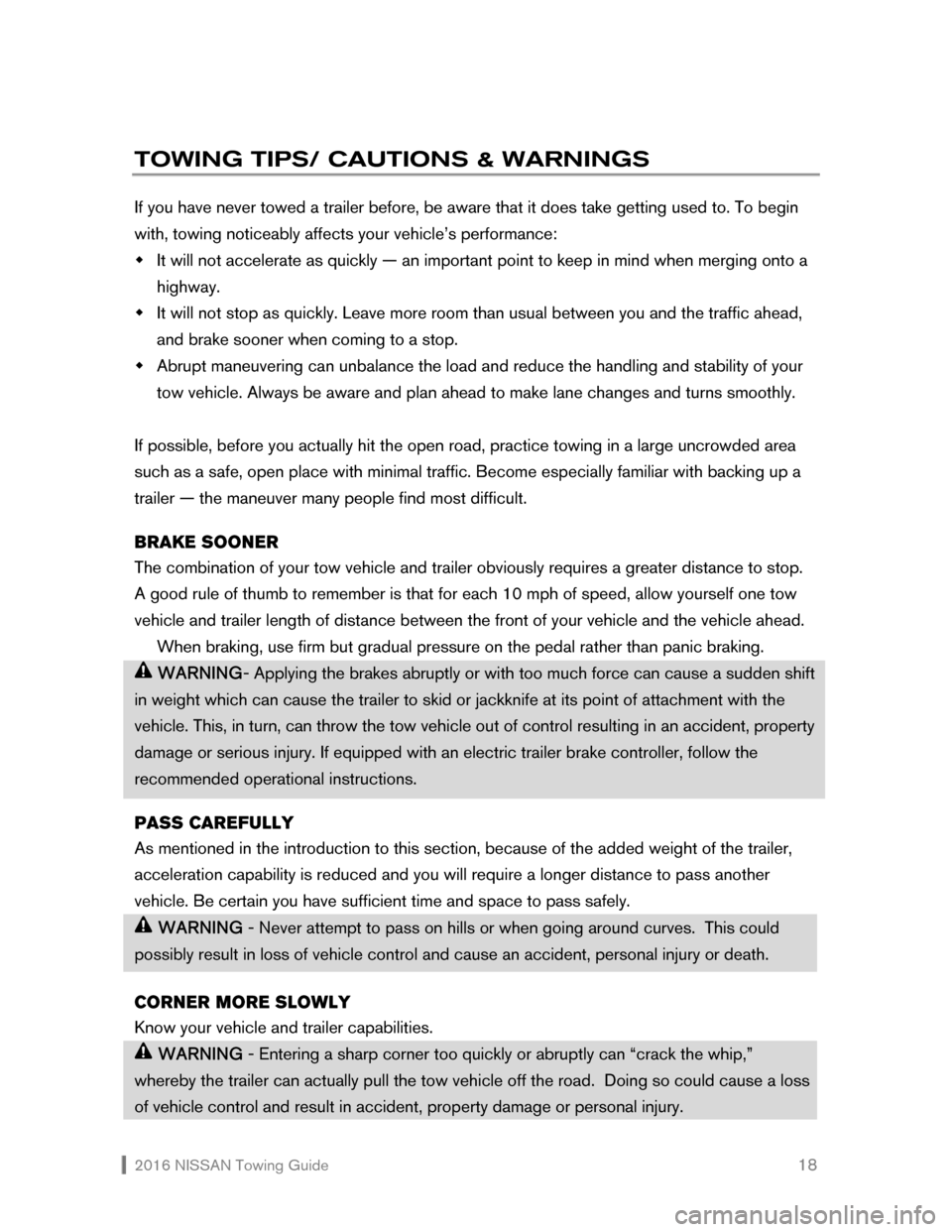
2016 NISSAN Towing Guide 18
TOWING TIPS/ CAUTIONS & WARNINGS
If you have never towed a trailer before, be aware that it does take getting used to. To begin
with, towing noticeably affects your vehicle’s performance:
It will not accelerate as quickly — an important point to keep in mind when merging onto a
highway.
It will not stop as quickly. Leave more room than usual between you and the traffic ahead,
and brake sooner when coming to a stop.
Abrupt maneuvering can unbalance the load and reduce the handling and stability of your
tow vehicle. Always be aware and plan ahead to make lane changes and turns smoothly.
If possible, before you actually hit the open road, practice towing in a large uncrowded area
such as a safe, open place with minimal traffic. Become especially familiar with backing up a
trailer — the maneuver many people find most difficult.
BRAKE SOONER
The combination of your tow vehicle and trailer obviously requires a greater distance to stop.
A good rule of thumb to remember is that for each 10 mph of speed, allow yourself one tow
vehicle and trailer length of distance between the front of your vehicle and the vehicle ahead.
When braking, use firm but gradual pressure on the pedal rather than panic braking.
WARNING- Applying the brakes abruptly or with too much force can cause a sudden shift
in weight which can cause the trailer to skid or jackknife at its point of attachment with the
vehicle. This, in turn, can throw the tow vehicle out of control resulting in an accident, property
damage or serious injury. If equipped with an electric trailer brake controller, follow the
recommended operational instructions.
PASS CAREFULLY
As mentioned in the introduction to this section, because of the added weight of the trailer,
acceleration capability is reduced and you will require a longer distance to pass another
vehicle. Be certain you have sufficient time and space to pass safely.
WARNING - Never attempt to pass on hills or when going around curves. This could
possibly result in loss of vehicle control and cause an accident, personal injury or death.
CORNER MORE SLOWLY
Know your vehicle and trailer capabilities.
WARNING - Entering a sharp corner too quickly or abruptly can “crack the whip,”
whereby the trailer can actually pull the tow vehicle off the road. Doing so could cause a loss
of vehicle control and result in accident, property damage or personal injury.
Page 20 of 27

2016 NISSAN Towing Guide 19
Therefore, when approaching a relatively sharp corner, begin braking sooner than you would
when not towing. Do your braking in a straight line prior to the corner, and turn smoothly into
it. In addition, remember to make a wider turn than normal to ensure that the trailer safely
clears the inside of the turn.
WARNING -When towing a 5th wheel or gooseneck trailer, do not make sharp turns while
driving or backing as the trailer may contact the vehicle and cause damage to both the trailer
and vehicle, or result in an accident leading to property damage or personal injury.
A special extended 5th wheel pin box or sliding hitch may be required to provide additional
trailer-to-truck clearance for tight maneuvering.
BACK UP WITH CAUTION
Backing up with a trailer is a difficult maneuver. The best way to steer is by placing one hand
at the bottom of the steering wheel to direct the trailer. The trailer will go in the same direction
your hand moves. If you want to turn the trailer to the left, you will turn the steering wheel to
the left. To turn the trailer to the right, move the wheel to the right. All movements of the wheel
should be done in small increments. Of course, backing up should be done only at very slow
speeds. For large trailers that obstruct your rearward vision, have someone outside the vehicle
act as a “spotter” to guide you along.
PARK SMART
A tow vehicle and trailer can be an unwieldy combination in a small area, so always try to park
where you will have a relatively easy time maneuvering. Once parked, always block the wheels
on both the tow vehicle and the trailer.
Parking on a slope is not recommended. If, however, you must park on a slope and your
vehicle is equipped with an automatic transmission, there are some precautions you should
take:
Have someone block the wheels once the tow vehicle and trailer are in position and are
being held by the vehicle’s brake.
Next, apply the parking brake and only then move the gear lever into PARK.
CAUTION - If you move the lever into PARK before blocking the wheels and applying the
parking brake, it may be difficult later to shift out of PARK. Transmission damage could also
occur.
HIGH-ALTITUDE PERFORMANCE
An engine will lose about 4% of its performance for every 1,000 feet above sea level that you
travel. If you will be towing in high altitudes, it is a good idea to allow more time than usual due
to the engine’s reduced performance.
Page 21 of 27
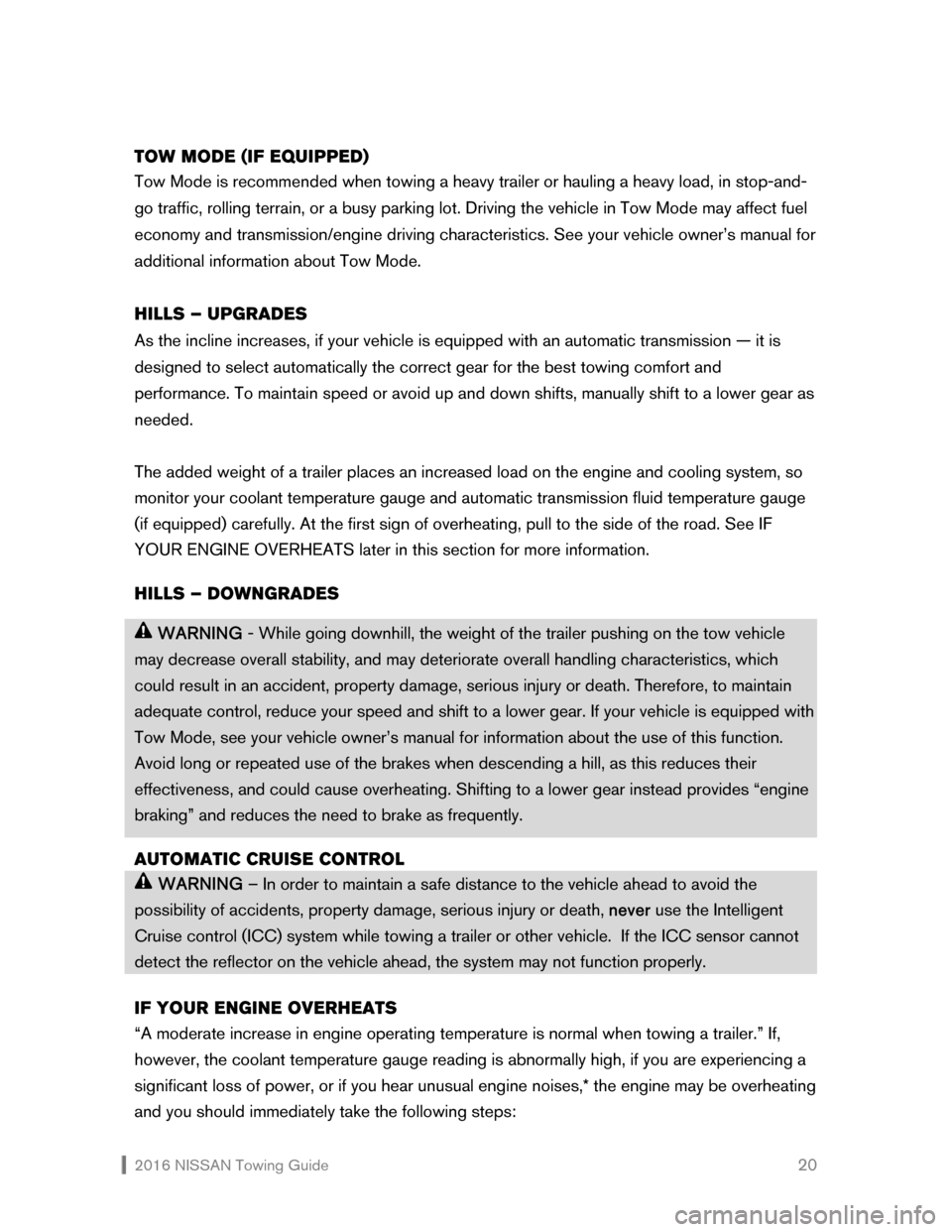
2016 NISSAN Towing Guide 20
TOW MODE (IF EQUIPPED)
Tow Mode is recommended when towing a heavy trailer or hauling a heavy load, in stop-and-
go traffic, rolling terrain, or a busy parking lot. Driving the vehicle in Tow Mode may affect fuel
economy and transmission/engine driving characteristics. See your vehicle owner’s manual for
additional information about Tow Mode.
HILLS – UPGRADES
As the incline increases, if your vehicle is equipped with an automatic transmission — it is
designed to select automatically the correct gear for the best towing comfort and
performance. To maintain speed or avoid up and down shifts, manually shift to a lower gear as
needed.
The added weight of a trailer places an increased load on the engine and cooling system, so
monitor your coolant temperature gauge and automatic transmission fluid temperature gauge
(if equipped) carefully. At the first sign of overheating, pull to the side of the road. See IF
YOUR ENGINE OVERHEATS later in this section for more information.
HILLS – DOWNGRADES
WARNING - While going downhill, the weight of the trailer pushing on the tow vehicle
may decrease overall stability, and may deteriorate overall handling characteristics, which
could result in an accident, property damage, serious injury or death. Therefore, to maintain
adequate control, reduce your speed and shift to a lower gear. If your vehicle is equipped with
Tow Mode, see your vehicle owner’s manual for information about the use of this function.
Avoid long or repeated use of the brakes when descending a hill, as this reduces their
effectiveness, and could cause overheating. Shifting to a lower gear instead provides “engine
braking” and reduces the need to brake as frequently.
AUTOMATIC CRUISE CONTROL
WARNING – In order to maintain a safe distance to the vehicle ahead to avoid the
possibility of accidents, property damage, serious injury or death, never use the Intelligent
Cruise control (ICC) system while towing a trailer or other vehicle. If the ICC sensor cannot
detect the reflector on the vehicle ahead, the system may not function properly.
IF YOUR ENGINE OVERHEATS
“A moderate increase in engine operating temperature is normal when towing a trailer.” If,
however, the coolant temperature gauge reading is abnormally high, if you are experiencing a
significant loss of power, or if you hear unusual engine noises,* the engine may be overheating
and you should immediately take the following steps:
Page 22 of 27

2016 NISSAN Towing Guide 21
1. Carefully pull your vehicle safely over to the side of the road, out of traffic. Apply the
parking brake and move the gearshift lever to NEUTRAL (manual) or PARK (automatic).
DO NOT STOP THE ENGINE.
2. Turn off the air conditioning and, after opening all the windows, turn the heater on to
maximum hot and the fan to its highest speed, and exit the vehicle. The heater core in your
vehicle is just like a miniature engine radiator and will provide an extra cooling surface to
help reduce engine temperature.
3. If the temperature does not drop or continues to increase, stop the engine immediately.
4. Being cautious of traffic, step out of the vehicle and, from a safe distance, look for steam
underneath the engine. If you see steam or leaking coolant, stand clear to avoid being
burned and shut off your engine immediately and allow it to cool. If there is no steam, open
the hood.
WARNING - To avoid the danger of being scalded, do not open the hood if steam is
coming out. Never remove the radiator cap when the radiator is hot. If the cap is removed
under these conditions, pressurized hot water/coolant may spurt out, possibly causing
serious injury.
5. As soon as the engine has cooled to its normal operating temperature, visually inspect the
drive belts for damage or looseness. A loose belt reduces water pump efficiency.
WARNING - Be careful to keep your hands, hair, jewelry, and clothing clear of the
running drive belt and other moving parts when inspecting the engine and radiator to avoid
being burned and to avoid personal injury, or death. Keep in mind, too, that if your vehicle is
equipped with an electric fan motor, it may start without warning any time the coolant
temperature is high. Also, check to see if the cooling fan is running, and inspect the water
pump, radiator, and radiator hoses for leaks.
If you find leaking coolant, a loose or missing drive belt, or an inoperable fan, turn off the
engine immediately.
6. If no leaks are apparent and all other components appear to be operating properly, when
the engine has cooled to its normal operating temperature; check the coolant level in the
reservoir tank with the engine running. Add coolant to the reservoir tank in accordance to
owner’s manual, if needed. At this point, if repairs are needed, go to the nearest NISSAN
dealer. See the IN CASE OF EMERGENCY section of your vehicle owner’s manual for
additional information on overheating.